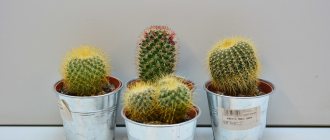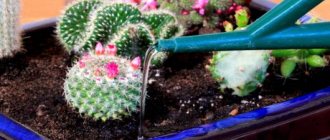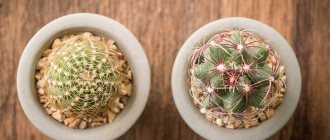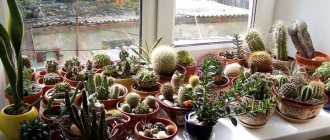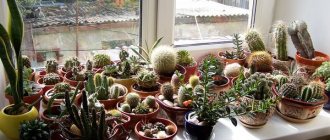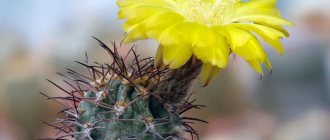Cacti with bright red, orange, purple or even blue spines are not uncommon in flower shops today. Of course, questions immediately arise: where do such beauties grow and why haven’t we seen them before? The answer is simple. Here, in nurseries, they have been found recently. Ever since they began to be actively fed with dyes.
Regular food coloring is used to color the spines. They are harmless and there have been no reports of illness or death caused by them. As a rule, it takes about three weeks to color the spines of a cactus in any color of the rainbow. The most reliable way is to mix primer with dye. Another option is watering with a colored solution.
Painted echinocactus Gruzoni @ succulents__garden, Instagram
The beauty of spines painted in this way does not last long. Once you stop supplying the plant with dye, they will take on their usual appearance. However, in nature there are also plants that boast unusual needle colors. It is not as bright as after dye, but natural.
Home care
The plant looks aesthetically pleasing and original, and requires a minimum of care.
Watering
In the spring, the cactus needs to be watered more often, and in other seasons, just like other indoor plants.
In the fall, it is best to completely limit watering. At this time, it needs to be watered rarely and little by little. In the summer, the cactus needs to be sprayed with a spray bottle.
Temperature
Like many cacti, Gymnocalycium is thermophilic. In the summer, it feels good at temperatures of +20, +30 degrees, and in winter the temperature should be reduced to +18 degrees.
Indoor Gymnocalycium needs bright sunlight, but in the summer heat it can get burned, especially if it is standing on the south side of the window.
Priming
The soil for the cactus should be slightly acidic or neutral; the cactus cannot tolerate acidic soil. You can use ready-made soil for such plants or make it yourself. To do this, you need to mix humus, peat, sand, expanded clay and charcoal in equal proportions.
Trimming
The plant needs pruning only if the roots rot:
They begin to water the plant after pruning three days later.
Pot
It is best to choose a clay pot for cacti , as the water will evaporate well in it. There is no need to use a pot that is too large; its walls should slightly touch the roots of the cactus.
Top dressing
At the time of flowering, the plant should be provided with frequent feeding from March to November.
You will need specialized fertilizer specifically for cacti. You need to feed twice a month. In winter, the cactus is not fed.
Transfer
The cactus should be replanted once every two or three years. For this:
Wintering
In winter, the cactus is at rest , so the air temperature in the room should not be higher than +18 degrees. There is no need to feed or water the plant at this time of year.
Growing conditions
Before describing the main action - the method of engraftment of the scion (transplanted children - Gymnocalycium Mihanovich, Stenopleurum and yellow-stemmed Chamecereus) to the rootstock cacti, to guarantee good engraftment, we will list the basic conditions for growing cacti - this will be useful to you when the stepchildren and “mothers” grow together, and they you will need proper nutrition and care.
The soil. For all of the above cacti, a slightly acidic soil mixture (pH = 5.5-6.0) is suitable, options:
- coarse river sand, leaf soil, finely ground charcoal, fine crushed stone and neutralized peat from the AGRO line in a ratio of 3:3:1:1:1;
- turf soil, pumice and sand (1:1:1);
- ready-made soil PETER PEAT “For cacti and succulents” from the HOBBY line.
If you plan to grow cacti with colored needles, the ratio of nutrient soil to natural food coloring added to the soil mixture should be 1:3.
In addition, the self-directed soil mixture must be sterilized: pour the soil mixture into gauze and tie the bag by the handles of the pan, into which you must first pour a third of the volume of water. Close the lid, bring to a boil and keep on low heat for half an hour.
Landing capacity. plastic/ceramic pot with a drainage layer made of expanded clay PETER PEAT line VITA with a layer of 15% of the volume and holes in the bottom, as well as a mandatory tray for collecting excess water. It is better to place the pots on identical stones Ø0.5-0.8 cm in trays, so that excess water does not destroy the plants when overflowing.
Lighting. It all depends on your wishes and capabilities, because... Thanks to the presence of phytolamps and the correct temperature in the room, cacti practically do not hibernate and grow without problems in winter. As soon as the length of daylight hours becomes less than 12 hours, it’s time to connect phytolamps to the process:
- halogen - suspended at a distance of 40 cm from the top of the cactus, while the temperature near the plant should not exceed + 32-35⁰С;
- sodium ones are more economical and intense than halogen ones, therefore they are suspended at a distance of 50 cm. Additional illumination time is at least 14 hours/day, until the first ten days of May in the conditions of central Russia.
But keep in mind that not all cacti tolerate intense light. For example, fryleys, pediocacti, and notocacti feel most comfortable in light partial shade. Additionally, familiarize yourself with the growing conditions for your variety.
Temperature and relative humidity. November-March: +8-11⁰С, 50%; March-April: +13-18⁰С, 60%; May-September: +22-26⁰С, October-November: +13-18⁰С, 60%. Check the growing conditions for your variety.
Watering. Perhaps the only thing that cacti react to sensitively and quite quickly is water. Try to water them with soft, settled, warm water (+18-22⁰С). At the same time, try not to get on the plant itself, but to water the soil. The next time for watering is when the top layer of soil dries approximately. In summer, in hot weather, water the cacti in the evening, the rest of the time - in the morning. Please note: the higher the air humidity and the lower the temperature of the room where your cacti are kept, the lower the amount of watering they require. They also like cacti and daily moderate fine spraying with settled water during the period of active growth (+35⁰С). If you do not illuminate your pets with phytolamps in the autumn-winter period, reduce watering during this time to a minimum - once a week.
Feeding. Offer your pets an ash-water solution (1:3). The hibernation time for most cacti occurs from October to March, and at this time they do not need feeding.
Reproduction by seeds and shoots
Cactus reproduces in two ways - by seeds and shoots.
Seeds
It is difficult to propagate the plant in this way, but in this case you can get a more hardy species. With this method of reproduction, the characteristic features of the species are lost.
For reproduction you will need:
Shoots will appear after ten days.
By shoots
If the plant is propagated using this method, grafting is also necessary.
This method is the simplest and most effective; many shoots take root quickly.
The shoots must be separated carefully without damaging the main stem. Otherwise, it will lead to infection.
The role of chlorophyll in the life of cacti and plants in general
As you know, cacti and all other plants have a green color due to the presence of chlorophyll in special cellular organelles - chloroplasts. It captures light energy to use the synthesis of organic substances, which in this case is called photosynthesis.
Without this process, plants cannot exist independently, which is why red cacti do not exist in nature.
Domestic multi-colored beauties receive organic substances from the rootstock plant. If a wild plant mutates and stops producing chlorophyll, it simply dies. In principle, it is possible to derive the color form of any cactus, for example, mammillaria, rebutia, astrophytum, and there have been such attempts. But only the colored forms of Gymnocolicium and Stenopleurum, as well as the yellow form of Chamecereus, turned out to be truly beautiful. These cacti mature quickly and therefore retain their natural appearance on the scion. Other species, when grafted, lose their natural beauty and stretch out unsightly.
An important factor in the distribution of red cacti of these particular species is also their tendency to vegetative propagation, otherwise it would be necessary to look for mutations among the seedlings to obtain each colored specimen.
Similar cacti
Gymnocalycium unites a wide variety of cacti. Below are the most popular ones:
Gymnocalycium japonica is a spectacular cactus that is easy to grow at home. You can collect a whole collection of different colors and shades of this plant and then your windowsill will look like a coral reef at any time of the year.
If you find an error, please select a piece of text and press Ctrl+Enter.
Source
All about colored cacti: photos of colored needles and stems, features of care and reproduction
Colored cacti are truly wonderful plants that can fall in love with a person at first sight.
The brightness and diversity of colors diversify even the most austere interior. Fireworks of flowers will maintain an entertaining atmosphere in the house and delight the owner with extraordinary beauty. Read more about the features of care, reproduction and possible pests in our article.
Gymnocalycium Michanovich
Our guest today is Gymnocalycium Mihanovichii , or as it is often called, Moon Cactus (Gymnocalycium Mihanovichii - Moon Cactus) native to Argentina and Paraguay. This cactus was first discovered by the Czech traveler Alberto Vojtecha Frich. Since all his expeditions were sponsored by Nikolas Mikhanovich, this species was named after him.
Lighting
Like all representatives of the genus Gymnocalycium, this species is very demanding on lighting - bright light is necessary. However, it should be remembered that at different times of the year the amount of direct sun on the plant plays a vital role. In autumn and winter, it is necessary to supplement the plant with phytolamps. In the summer months and late spring, you should be more careful when approaching midday light. It is direct sunlight in the brightest and hottest weather that can cause burns.
About coloring
When you see painted cacti, the question involuntarily arises: “Why are they painted?”
The thing is that most people are not able to appreciate the natural beauty of succulents. They rarely bloom; the gloomy green color often repels lovers of delicate shades. Sellers cleverly take advantage of this and, in order to increase demand for cacti, paint them in different colors. It is not surprising that hardly anyone will pass by such beauty. The dyeing procedure is completely harmless to the plant. The main thing is to use a safe dye, and then the succulent will not notice the introduction of a foreign substance. After just a few months, a slight tint will appear.
Below you can see a description and photo of cacti with painted and naturally colored needles, stems and bright flowers.
Variety of species: names and characteristics
It has a flattened stem that is either grayish-green or brownish-reddish in color. Gymnocalycium michanovicha blooms in red, white, pink, yellow or orange flowers.
This cactus is brown, red-brown or lilac-burgundy. It contains the least chlorophyll. The common people call it “Little Red Riding Hood” for its appearance.
This is a form of Gymnocalycium Friedrich. Due to the complete absence of chlorophyll, the plant has a bright stem color. The most common colors are deep yellow or red. This species is grafted onto any green variety, because it cannot take root in the ground. It turns out a very beautiful mix of bright, rich shades.
A dark green cactus with a flattened, spherical stem covered with small yellow spines. The cactus has 4-6 rounded ribs. In late spring, hippocalycium blooms with lilac-pink flowers with pink stripes in the center of the petal.
It is grown in groups. The cactus does not like abundant watering and excess light. Its flowers form bushes of many bright yellow heads.
Begins to bloom earlier than other varieties. Already in early summer, purple flowers will appear. And the stem of Gymnocalycium baldiamum is gray-green with a blue tint.
What is interesting about the chlorophyll-free red forms?
The “red cacti” created a real sensation among cactus growers. It was first bred by the Japanese in 1940, so this home flower is often called Gymnocalycium japonica.
In the photo: a rather original succulent plant, a bright red cactus on a thin green stalk - Gymnocalycium Michanovichi, Friedrich's variety (G. michanovichii var. friedrichiae).
These succulents lack chlorophyll and are able to exist without full photosynthesis. “Mikhanovichi” grow only grafted onto another slowly growing green columnar cactus, receiving the missing substances from it.
Currently, there are other non-chlorophyll color forms of this cactus - bright and saturated yellow, pink, orange and even purple, which looks incredibly exotic. Grafted onto an elongated green cactus and imported from Holland, Gymnocalycium michanovichi appears on the shelves under the names: “neon cacti”, “red cap”, “orange cap”, etc.
In principle, it is possible to derive the colored form of not only Gymnocalycium, for example, Mammillaria, Rebutia. Cacti grow well, feed on the rootstock, and do not require special care. Unfortunately, the lifespan of these cute mutants is limited - 3-5 years.
Photo: Gymnocalycium stenopleurum... The stem is red in various shades, usually overgrown with many bright children.
Home care
Gymnocalycium is easy to care for. The cactus is very persistent. Perfect for beginner gardeners. Gymnocalycium is unpretentious. To care for it at home, just follow the following recommendations.
Autumn and winter are quiet times for Gymnocalycium. If there is little light, it is recommended to provide additional artificial lighting.
Gymnocalycium does not tolerate excess moisture. Water it as it dries with warm water that has settled for a day or two. In summer, watering will be plentiful, and closer to autumn it will be reduced. Spraying with water is not recommended. This causes white marks to appear on the plant.
NOTE
In cold weather, reduce watering to two or three times per season.
For planting, you can buy ready-made soil for cacti at a gardening store. Or make a suitable mixture yourself. To do this, mix humus, peat, turf in equal quantities and add a little brick chips and charcoal.
Feed Gymnocalycium in spring and summer at intervals of 1-2 weeks with special fertilizers for cactus plants. In winter, the cactus goes into a dormant state, so it is better to interrupt feeding.
The plant should be replanted in the spring. The pot is a little larger than the old one. The cactus is quite comfortable blooming in cramped conditions. Young gymnocalycium is replanted annually, and an adult every four years.
The humidity can be any. The cactus thrives in both dry and humid climates.
There is no need to specially moisten it by spraying.
Echinocactus grusonii
A spherical cactus native to Mexico with a green body and strong spines in various shades of yellow.
Main characteristics:
- lat. Echinocactus grusonii (echinos – hedgehog);
- in nature it grows up to 150 cm in height, up to 100 cm in diameter, at home up to 50 cm in diameter;
- blooms in spring, over 20 years of age, extremely rarely at home;
- light-loving, requires placement on southern windows.
Echinocactus Gruzoni is one of the most common indoor plants. His good looks and unpretentiousness made him a favorite among flower growers. A cactus similar to a golden hedgehog requires only bright lighting and rare watering as the soil dries completely.
There is also a variety with white spines. It is believed that this mutation appeared spontaneously in greenhouses.
Echinocactus grusonii var. brevispinus @kaktusmamah, Instagram
Echinocactus [email protected] 0310hachi, Instagram
The white spines of the cactus have an interesting property: when exposed to the sun, they darken, gradually acquiring a bronze “tan.” The new ones grow completely white.
The plant is thermophilic and will not tolerate drafts or cold temperatures below +10. This is the minimum at which it is willing to spend the winter. The active growth phase begins at temperatures from +20. However, if the thermometer rises above +30, it will go into suspended animation and stop increasing in size.
The echinocactus Gruzoni is in no hurry to increase its mass: in favorable conditions, without strong shocks, it will live for more than 100 years. Botanists believe that some of the cacti of this variety growing on Earth managed to celebrate their 500th anniversary.
It does not produce side shoots and reproduces by seeds.
Reproduction
There are two ways to propagate Gymnocalycium: by seeds and by lateral layering.
The first method makes it possible to obtain higher quality and healthier offspring. The seeds are planted in a small pot with a moistened mixture. Before planting, the soil must be calcined in the oven for disinfection. At first, it is better to cover the seeds with a film or a lid so that the soil is constantly moist. At the same time, do not forget to spray or water through the pan. A temperature of 18-20 degrees is suitable for seed germination. Within a year, the seedlings can be planted in separate pots. You can plant seeds at any time of the year. The main thing is to comply with all conditions.
The second method is simpler. It is necessary to separate the side cuttings from the main stem and dry the cut area for several days. To do this, place the shoot on the newspaper. Let it sit for a few days. Then we plant it in moist soil. It will take root very quickly, and you need to care for it like an adult cactus. If the children have roots, then you need to carefully dig it out and transplant it into a separate pot.
A little history
The red cactus was first bred by the Japanese biologist Watanabi. Taking a Gymnocolicium seedling with red spots (such a small mutation is not uncommon among cacti), I cut out a red areola and grafted it onto an Echinopsis cactus (an areola is a specific formation in a cactus, containing spines and hairs, and suitable for rooting and grafting). I again took the areola with redness from the grown cactus and again grafted it onto a green cactus.
After repeating this procedure many times, he managed to get a completely red cactus grafted onto a green, unpretentious echinopsis. The red caps of Gymnocalyciums created a real sensation among cactus growers and at first were incredibly expensive.
Then it turned out that they reproduce perfectly, only the red baby cannot be planted in the ground, it will die, it needs to be grafted onto some green cactus and you will get a new beautiful specimen with a red cap. Even a novice cactus grower can easily carry out this procedure.
Graft
Vaccination is necessary for non-chlorophyll cacti. Such gymnocalyciums are red in color. It is difficult for them to grow separately, so the best option for them is crossing with a green cactus. The result is a very beautiful variety with green and red stems at the same time.
Gymnocalyciums are grafted in the same way as other cacti. Cuts are made on both plants. They are connected by connecting the conductive bundles. And, having chosen the desired position, secure it with a bandage. The main thing is not to fasten it too tightly. The bandage is not removed for a week.
Feel like a breeder - paint the cactus yourself
You can change the color of the needles on your succulents yourself. This is not at all difficult to do, but it will take a lot of time until the process is completely completed. To paint, you will need food coloring in the desired color. It is as safe for the plant itself as it is for us; we use similar products in cooking. Now just add a little dye to the water every time you water. And gradually, after 5-6 months, its needles, and sometimes the “body” itself, will change color.
For experiments, choose only young specimens and preferably short ones. Old cacti, like tall ones, grow slowly, and their thorns acquire a protective coating through which the dye is difficult to penetrate.
Having achieved the desired result, do not abandon your brainchild - the coloring must be maintained. Otherwise, the cactus will return to “factory settings” again. To do this, water colored succulents more often than regular ones, but with less liquid (with added dye). Also provide the plants with good lighting, and when replanting, first water the new soil with water and dye.
Diseases and pests
The red flat mite causes the greatest damage to cacti. Gymnocalycium has a very thick skin, so the pest rarely settles on it. Mostly young sprouts with thin, fragile skin are at risk. The appearance of a tick can be identified by dry, rust-colored spots. To get rid of it, spread the stems with ethyl solution or rinse under running hot water. You can, of course, buy a universal pesticide, but it is better to do this in extreme cases, when not just one, but an entire family of cacti is under threat.
Mealybugs can settle on the roots or stems of Gymnocalycium . This is a small pinkish worm that sucks the sap from plants. It can be seen with the naked eye. If the pest settles in the roots of the plant, then the flowers stop appearing and the gymnocalycium no longer grows. To get rid of scale insects, rinse the roots with hot water for a long time or buy special medicines in the store.
In addition to pests, Gymnocalycium is susceptible to rot. They occur if the plant is watered too intensely or kept at the wrong temperature. Most often the roots are affected. To save the cactus, you need to rinse the affected areas with hot water. Cut off all rot, and disinfect the healthy part with crushed coal or fungicidal preparations. Then dry the roots for several days and plant them in a new pot.
Source
